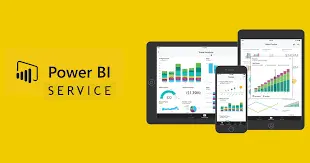Estimated reading time: 5 minutes
A comprehensive overview of what Power BI is, explaining its capabilities for transforming data into actionable insights for businesses.
In today’s data-driven world, businesses are constantly seeking efficient ways to interpret and visualize their data. This is where Power BI comes in, a powerful data visualization tool developed by Microsoft. But what exactly is Power BI, and how does it work? In this article, we’ll explore Power BI’s features, benefits, and how it can transform your business data into actionable insights.

What is Power BI?
Power BI is a collection of software services, apps, and connectors that work together to turn unrelated sources of data into coherent, visually immersive, and interactive insights. Whether your data is an Excel spreadsheet or a collection of cloud-based and on-premises hybrid data warehouses, Power BI helps you easily connect to your data sources, visualize and discover what’s important, and share that with anyone or everyone you want.
Key Components of Power BI
Power BI is comprised of several components that provide a robust data analysis experience:
- Power BI Desktop: A downloadable application that allows users to connect to, transform, and visualize data. It is the primary tool for creating reports and data models.
- Power BI Service: A cloud-based service where users can share, collaborate, and manage their data and reports.
- Power BI Mobile: Mobile applications available on iOS, Android, and Windows devices to access and interact with data and reports on the go.
- Power BI Report Builder: A tool for creating paginated reports, which are ideal for printing or sharing in PDF format.
- Power BI Report Server: An on-premises report server that provides a secure location to store and manage your reports and data.
How Does Power BI Work?
Power BI operates in three main steps:
- Data Connection: Power BI connects to a wide range of data sources, from simple Excel files to complex databases and online services like Google Analytics, Salesforce, and Microsoft Azure. It can consolidate data from multiple sources into a single dashboard.
- Data Transformation: With Power Query, users can clean, merge, and shape their data to fit their needs. This step allows you to filter, sort, and transform data into usable formats.
- Data Visualization: Power BI offers a variety of data visualization tools like bar charts, pie charts, line graphs, maps, and more. These visuals help in understanding trends, patterns, and outliers within your data.
Why Use Power BI? Benefits for Businesses
Power BI offers several advantages that make it a preferred choice for data visualization and business intelligence:
- User-Friendly Interface: Its drag-and-drop interface and intuitive design make it easy for beginners and professionals alike to create stunning reports and dashboards.
- Scalability: Power BI can scale with your business, accommodating the needs of small businesses to large enterprises with massive datasets.
- Real-Time Data Analysis: With real-time data connectivity, Power BI provides up-to-date insights that help businesses make faster and more informed decisions.
- Collaboration and Sharing: You can easily share reports and dashboards with your team, enabling collaborative decision-making.
- Affordable Pricing: Power BI offers a free version and affordable Pro and Premium versions, making it accessible to businesses of all sizes.
Use Cases for Power BI
Power BI is versatile and used across industries to meet a variety of data visualization needs:
- Finance: Monitor key financial metrics, visualize cash flows, and forecast revenue.
- Marketing: Analyze customer data, track campaign performance, and monitor website analytics.
- Sales: Evaluate sales pipelines, track conversion rates, and monitor customer satisfaction.
- Operations: Optimize supply chain processes, monitor inventory levels, and track project performance.
Getting Started with Power BI
To begin using Power BI, you can download Power BI Desktop from the official Microsoft website. There are also various online tutorials and courses available to help you get acquainted with the tool. Start by connecting to a data source and experimenting with the visualization options to create your first report.
Power BI vs. Other BI Tools
While Power BI is a leading tool in business intelligence, it’s essential to compare it with other tools like Tableau, Qlik, and Google Data Studio to determine the best fit for your business. Power BI stands out for its integration with Microsoft products, ease of use, and affordability.
Frequently Asked Questions (FAQs)
A: Yes, Power BI offers a free version with basic features. However, advanced features are available in the Pro and Premium versions.
2. Can I use Power BI on my mobile device?
A: Yes, Power BI Mobile is available for iOS, Android, and Windows devices.
3. What data sources does Power BI support?
A: Power BI supports a wide range of data sources, including Excel, SQL Server, Azure, Google Analytics, and many more.
With this information, you’re ready to explore Power BI and see how it can transform your business data into actionable insights. Give it a try and take your data analysis capabilities to the next level!
Conclusion
Power BI is an invaluable tool for businesses looking to harness their data for better decision-making. With its robust features, seamless integration capabilities, and affordable pricing, Power BI is ideal for companies of all sizes. Whether you’re new to data visualization or an experienced analyst, Power BI provides the tools you need to make data-driven decisions with confidence.
